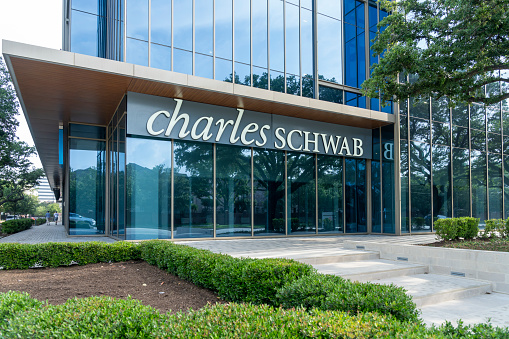When shares of The Charles Schwab Corporation (NYSE:SCHW) posted its results for the first quarter of this year, I believed that there was some strength seen under the hood. That strength cooled off a bit during the second quarter, with client inflows slowing, deposit outflows continuing, and the company waiting on interest rate cuts to drive earnings growth from here.
Amidst the impact of higher interest rates and deposit migration, the company is looking to improve the strength of the balance sheet, halting and deferring share buybacks, something which hurts near term capital returns to investors.
This frankly should not be surprising, but somehow seems to surprise investors here. While a 15% pullback is substantial and normally appealing, I am still approaching the situation with caution here.
Putting The Turmoil Behind
Shares of Charles Schwab traded around $75 per share early in 2023, as the (regional) banking crisis created significant turmoil. Shares fell to just $60 in the time frame of two days, and to the $50s in the weeks which followed.
The reason was simple. With interest rates being in the rise, depositors and investors were moving deposits into higher yielding instruments, creating pressure on banks and financial institutions, including Schwab. This meant that all players needed to hike payments on customer deposits to limit outflows, while raising other and more expensive sources of funds. Some weaker players were even forced to sell long term financial instruments discounted, triggering capital losses in the meantime.
All of this was, of course, not yet visible in the 2022 results, a year in which Schwab grew sales by 12% to $20.8 billion. The company posted huge GAAP earnings of $7.2 billion, equal to $3.50 per share, with GAAP earnings posted around $4 per share.
Being a bank and broker under a single roof, and Schwab effectively paying less than 50 basis points on a $367 billion deposit base by year-end 2022, the door for deposit migration was wide open. Clients could yield up to 4% in risk-free bonds and bills. At best, Schwab had to raise deposit rates to maintain funds, and attract other funds, but at worst, capital losses might be incurred.
Deposits fell by a whopping $41 billion in the first quarter of 2023, down other $21 billion in the second quarter, another $20 billion in the third quarter. Deposits actually rose by $5 billion in the final quarter, to arrive at $290 billion by year-end 2023. At the same time, the company effectively hiked the payment rate to 1.37% on these sources of funds.
All this meant that adjusted earnings fell by near a dollar to $3.13 per share (adjusted) in 2023. Schwab was aided by a solid performance of the broker business, with assets under administration up to $8.5 trillion.
Worrisome was that earnings were trending below a rate of $3 per share at the time, offset by synergies from the Ameritrade deal, as well as potential for more fees generated from the broker business as well.
Starting 2024 On A Solid Note
In April, Schwab posted solid first quarter results with clients asset up to $9.1 trillion, driven by $96 billion in inflows and markets trading at fresh highs. Total revenues were down 7% on an annual basis to $4.74 billion, up from the fourth quarter, as bank deposits fell from $290 billion to $270 billion, as the company keeps on resorting to more expensive forms of borrowing. First quarter earnings were down a fifth to $0.74 per share (adjusted) still leaving a roadmap for earnings to come in around $3 per share.
Trading in the low seventies, I believed the worst was behind, but that no immediate appeal was to be found, with shares trading at par to the pre-interest rate crisis.
The second quarter results revealed continued stagnation, with sales seen up a percent (on an annual basis) to $4.7 billion, with adjusted earnings of $0.73 per share down two pennies. Net interest income pressure is offset by higher revenues from the broker business. Bank deposits fell further to $258 billion, but by now the balance sheet of the bank is down substantially to $419 billion as well, as the company keeps shedding assets from the balance sheet. Core asset inflows were down to $61 billion, with client assets up to $9.4 trillion.
What Now?
The truth is that the earnings power now trends at just $3 per share. This results in a mid-twenty earnings multiple in the mid-seventies, something which was lowered as shares fell some 15% to $63 and change upon the release of the second quarter results.
This is likely the result of comments by CFO Peter Crawford, who said that the firm is looking to reduce bank debt, building up more reserves, not boding well for dividend increases or share buybacks.
More so, anecdotal evidence continues to show customer service concerns among former TD Ameritrade account holders, having migrated to Schwab. Another concern is unfriendly customer service practices (which includes automatic cash sorting of cash holdings in client accounts).
All this does not bode well for earnings in the near term, as the company trades at a premium to the market with few immediate earnings triggers to show for. One such potential trigger might be upcoming interest rate cuts, as the company believes that net interest margins (now coming in around 2%) might go up towards the 3% mark in 2025, which feels optimistic. This could boost adjusted earnings power to $0.80-$0.90 per share, but for this, obviously a lot still needs to go right.
Given all of this, I am still holding a neutral stance here for The Charles Schwab Corporation, although that appeal has improved a great deal following the second quarter earnings report. Shares feel a bit expensive, but this might easily normalize if interest rates start to come down and net interest rate margins might increase again. However, it is the anecdotal evidence on consumer service and continued deposit migration seen last year (which is ongoing) which means that I continue to approach the situation with caution here, despite the substantial fall recently.
Read the full article here






